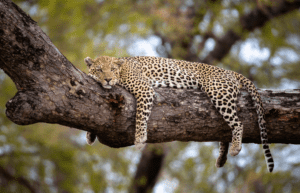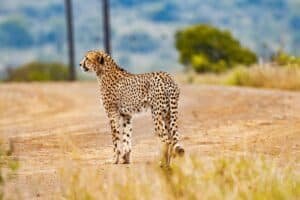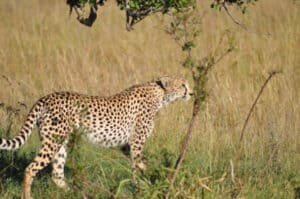Have you ever wondered that How Do Cheetahs Protect Themselves? Cheetahs are known for their impressive agility and speed, capable of reaching up to 70 miles per hour in just a few seconds. These big cats may be swift hunters, but they also face many threats in the wild. As such, they have developed various ways to protect themselves from danger.
Here are some ways that cheetahs protect themselves in their natural habitat.
- Camouflage: Cheetahs have a unique spotted coat that helps them blend in with their surroundings, making them almost invisible to predators. Their tan and black fur provides excellent camouflage in the savannah grasslands where they live.
- Sharp claws: The cheetah’s retractable claws are not only powerful weapons for hunting but also useful for self-defense. When threatened, they can use their sharp claws to fight off predators or climb trees to safety.
- Speed: As previously mentioned, cheetahs are incredibly fast animals. They use their speed not only for hunting but also to escape from danger. If a predator gets too close, the cheetah will run away at full speed.
- Group living: Cheetahs are solitary animals, but they often form small groups of two to four individuals, usually siblings. This group living strategy offers protection from predators and also allows them to hunt more efficiently.
- Mother’s protection: Cheetah mothers are very protective of their cubs and will do anything to keep them safe. They will hide the cubs in dense vegetation or sheltered areas to keep them safe while they go out hunting.
- Scent marking: Cheetahs use scent marking as a way to communicate with other cheetahs and also mark their territory. By urinating on trees or rocks, they send a clear message to other animals that this is their territory, and trespassers will be dealt with accordingly.
Table of Contents
Importance of self-protection for survival in the wild

For any animal species, self-protection is crucial for survival in the wild. In the case of cheetahs, their ability to protect themselves from potential dangers plays a significant role in their survival and well-being. With predators such as lions, hyenas, and leopards always on the prowl, cheetahs must be constantly vigilant and ready to defend themselves.
Moreover, in recent years, human activities such as poaching and habitat destruction have become major threats to the survival of cheetahs. In these situations, their natural defense mechanisms may not be enough to keep them safe. This highlights the importance of conservation efforts and responsible behavior towards wild animals.
Physical Adaptations vs. Behavioral Strategies
When it comes to self-protection, animals can either rely on physical adaptations or behavioral strategies. Cheetahs have evolved to have a combination of both.
Physical adaptations, such as their speed and sharp claws, are inherent traits that cheetahs utilize for protection. On the other hand, their behavioral strategies, such as camouflaging and group living, are learned behaviors that help them survive in their environment.
Cheetahs Preferred habitats for protection

How Do Cheetahs Protect Themselves? Cheetahs typically inhabit open, grassy areas where they can easily spot and outrun their prey. However, these habitats also provide limited hiding places for the cheetahs themselves. As a result, they are often found in areas with dense vegetation or rocky outcroppings where they can hide and seek refuge if needed.
Additionally, cheetahs are known to avoid areas with high predator densities, such as those inhabited by lions or hyenas. This shows their awareness of potential dangers and how they actively seek out safer habitats for self-protection.
Social Structure and Cooperation
While cheetahs are solitary animals, they do exhibit some cooperative behaviors, especially when it comes to self-protection. As mentioned earlier, they sometimes form small groups with other cheetahs, usually siblings. In these groups, they can work together to defend against predators and also help each other hunt for food.
Furthermore, the mother-cub dynamic is also an essential aspect of cheetahs social structure. Cheetah cubs stay with their mother until they are about 18 months old, during which time the mother teaches them important survival skills and protects them from potential dangers.
Role of cheetahs in the ecosystem

Apart from being a magnificent and iconic species, cheetahs also play a crucial role in their ecosystem. As top predators, they help regulate the population of their prey species, which in turn affects the entire food chain.
Furthermore, cheetahs are also important for maintaining biodiversity. Their presence helps ensure balance in the ecosystem and prevents any one species from becoming too dominant.
Conclusion
In conclusion, cheetahs have developed various ways to protect themselves in the wild. Their unique physical adaptations and behavioral strategies enable them to thrive in their natural habitat and increase their chances of survival. As humans, it is our responsibility to respect and protect these magnificent animals so that future generations can continue to admire and learn from them.
Read Also: Can Cheetahs Climb Trees?





